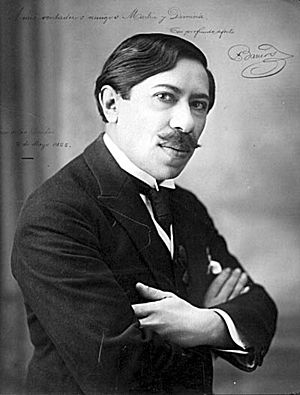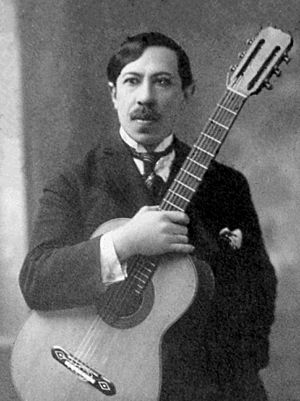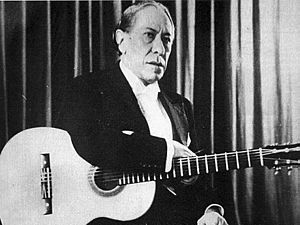Agustín Barrios facts for kids
Quick facts for kids Agustín Barrios |
|
|---|---|
 |
|
| Background information | |
| Native name |
Agustín Pío Barrios
|
| Born | May 5, 1885 San Juan Bautista, Paraguay |
| Died | August 7, 1944 (aged 59) San Salvador, El Salvador |
| Occupations | Guitarist, composer |
| Instruments | Classical guitar |
Agustín Pío Barrios (born May 5, 1885 – died August 7, 1944) was a famous classical guitarist and composer from Paraguay. Many people think he was one of the best guitar players and composers ever. He was also known as Agustín Barrios Mangoré and Nitsuga Mangoré. "Nitsuga" is "Agustin" spelled backward.
Contents
About Agustín Barrios
Where He Was Born
Agustín Barrios was likely born in San Juan Bautista, Paraguay. However, some people believe he was born in Villa Florida, a town nearby. His birth records don't clearly state the exact place.
His Early Life
As a child, Barrios loved music and books. These were very important to his family. He learned to speak Spanish and Guarani. He could also read English, French, and German.
Barrios became interested in musical instruments, especially the guitar, before he was a teenager. When he was 15, he moved to Asunción in 1900. He went to Colegio Nacional de Asunción, becoming one of the youngest university students in Paraguay. He studied music but was also good at math, writing, and literature. He was a skilled artist and worked for a time at a bank and in the Paraguayan Navy.
After college, Barrios spent his life on music, poetry, and travel. He wrote over 100 original songs and arranged 200 more by other composers. He made many friends while traveling across South America. He often gave signed copies of his poems to friends and fans.
His Music Career
Barrios was famous for his amazing live shows and recordings. Some people who saw him play said he was even better than other famous guitarists of his time. He was one of the first classical guitarists to make recordings, starting around 1909 or 1910.
Sometimes, Barrios performed in traditional Paraguayan clothes. He was partly from the Guaraní group. Starting in 1932, he used the stage name Nitsuga Mangoré. "Nitsuga" is "Agustín" spelled backward, and "Mangoré" was the name of a famous cacique (leader) of the Timbú people.
His music often sounded like late-Romantic style, even though he lived in the 20th century. Many of his songs were also inspired by folk music from South and Central America. His pieces are known for being very difficult and impressive to play.
One of his most famous pieces is La Catedral (The Cathedral), which he wrote in 1921. Even other famous guitarists admired this work. It has a calm, introductory part and a very fast, exciting part.
Later Life and Passing
After touring Europe in 1934-1935, Barrios performed in many countries like Venezuela, Cuba, and El Salvador. He eventually moved to El Salvador. There, he accepted an invitation from the President, Maximiliano Hernández Martínez. He took a job teaching at the Conservatory and Declamation Rafael Olmedo.
Barrios stayed in El Salvador for the rest of his life. He passed away on August 7, 1944. After his death, his handwritten music and scrapbooks were taken by some of his students.
His Legacy
The Twelve "Mangoreanos"
During his career, Barrios taught many students. After he moved to El Salvador in 1940, he wrote a guitar method. He taught a special group of students, mostly from El Salvador. They were known as the "Twelve Mangoreanos":
- Luis Mario Samayoa
- Benjamín Cisneros
- Rubén Urquilla
- René Cortés-Andrino
- Mario Cardona Lazo
- Jesús Quiroa
- Jose Cándido Morales
- Julio Cortés-Andrino
- Cecilio Orellana
- Roberto Bracamontes
- Víctor Urrutia
- Elena Valdivieso
Jose Cándido Morales and Roberto Bracamontes lived with Barrios and learned directly from him. After Barrios passed away, Morales helped keep his musical style and later works alive.
Folk Music Influence
The folk music of Paraguay, like the polca paraguaya, was Barrios's first introduction to music. In 1898, he started learning classical guitar from Gustavo Sosa Escalada. Barrios already played and wrote some guitar pieces. His new teacher encouraged him to study works by famous classical guitarists like Tárrega and Sor. Sosa Escalada was so impressed that he convinced Barrios's parents to let him move to Asunción for more education. Around 1905, Barrios began to compose seriously.
Barrios often played popular Paraguayan folk songs such as "Campamento Cerro León" and "Guyrá campana." You can even hear parts of "Guyrá campana" in some of Barrios's recordings, like "Caazapá — Aire Popular Paraguayo." "Guyrá campana" is a traditional song that often imitates bird sounds.
As a Composer
Barrios's music can be put into three main types:
- Folkloric: These pieces were inspired by folk songs and people from South and Central America.
- Imitative: He used styles and techniques from older music periods, like the Baroque and Romantic eras.
- Religious: Some of his works were inspired by religious themes. Una Limosna por el Amor de Dios (Alms for the Love of God) is an example of this type.
His Music Recordings
- Agustin Barrios: The Complete Guitar Recordings 1913–1942 – This is a collection of his old recordings, put together into a 3-CD set.
- Agustín Barrios: Complete Music for Solo Guitar – This is a 6-CD set released in 2010, featuring all his solo guitar music.
Important Works
Over 300 of Barrios's songs and arrangements still exist today. Many people in Latin America see him as one of the greatest musicians ever. The famous guitarist John Williams said that Barrios was the best guitarist and composer, no matter the time period. He felt Barrios's music was more poetic and well-formed.
Here are some of his well-known pieces:
- Abrí la Puerta Mi China
- Aconquija (Aire de Quena)
- Aire de Zamba
- Aire Popular Paraguayo
- Aires Andaluces
- Aires Criollos
- Aires Mudéjares (fragment)
- Aire Sureño (fragment)
- Allegro Sinfónico
- Altair
- A Mi Madre-serenata
- Arabescos
- Armonías de América
- Bicho Feo
- Canción de la Hilandera
- Capricho Español
- Choro da Saudade
- Confesión (Confissao de Amor)
- Contemplación
- Córdoba
- Cueca (Danza Chilena)
- Danza en Re Menor
- Danza Guaraní
- Danza Paraguaya no.1
- Danza Paraguaya no.2 'Jha, che valle'
- Danza Paraguaya (duet version)
- Diana Guaraní
- Dinora
- Divagación en Imitación al Violín
- Divagaciones Criollas
- Don Perez Freire
- El Sueño de la Muñequita
- Escala y Preludio
- Estilo Uruguayo
- Estilo
- Estudio de Concierto No.1 in A major
- Estudio de Concierto No.2 in A major
- Estudio del Ligado in A major
- Estudio del Ligado in D minor
- Estudio en Arpegio
- Estudio en Si Menor (solo and duet)
- Estudio en Sol Menor
- Estudio Inconcluso
- Estudio No. 3
- Estudio No. 6
- Estudio Para Ambas Manos
- Estudio Vals
- Fabiniana
- Gavota al Estilo Antiguo
- Habanera
- Humoresque
- Invocación a Mi Madre
- Jha, Che Valle
- Julia Florida (barcarola)
- Junto a tu Corazón
- Jota
- La Bananita (tango)
- La Catedral: Preludio – Andante – Allegro
- La Samaritana
- Las Abejas
- Leyenda de España
- Leyenda Guarani
- London Carapé
- Luz Mala
- Mabelita
- Madrecita
- Madrigal Gavota
- Maxixe
- Mazurka Apasionata
- Medallón Antiguo
- Milonga
- Minuet in A major
- Minuet in A major
- Minuet in B major
- Minuet in C major
- Minuet in C minor
- Minuet in E major
- Oración (Oración de la Tarde)
- Oración por Todos
- Pepita
- Pericón in F
- Pericón in G
- Preludio Op. 5, No. 1
- Preludio in E major
- Preludio in A minor
- Preludio in C major
- Preludio in C minor
- Preludio in D minor
- Preludio in E minor
- Romanza en Imitación al Violoncello (Página d¹ Album, Fuegos Fátuos)
- Sargento Cabral
- Sarita
- Serenata Morisca
- Tango No. 1
- Tango No. 2
- Tarantella (Recuerdos de Nápoles)
- Tua Imagem
- Una Limosna por el Amor de Dios (Also known as "El ultimo trémolo" or "El último canto")
- Un Sueño en la Floresta (Souvenir d¹un Reve)
- Vals de Primavera
- Vals Op. 8, No. 1 (Junto a tu Corazon)
- Vals Op. 8, No. 2
- Vals Op. 8, No. 3
- Vals Op. 8, No. 4
- Vals Tropical
- Variaciones sobre un Tema de Tárrega
- Variaciones sobre el Punto Guanacasteco
- Vidalita con variaciones in A minor
- Vidalita in D minor
- Villancico de Navidad
- Zapateado Caribe (trio)
He also wrote a couple of poems:
- Mi Guitarra (My Guitar)
- El Bohemio (The Bohemian)
His Guitars
When Barrios was in Paraguay, he only had access to guitars that weren't the best quality. But after he moved to Buenos Aires in 1910, he started playing some of the finest guitars of his time. He usually traveled with two guitars. Many of his guitars were changed to have an extra fret (the 20th fret). Photos show him playing guitars made by famous Spanish guitar makers like Manuel Ramirez and Domingo Esteso. He also played guitars from Brazil and Uruguay.
Film About His Life
On August 21, 2015, a movie called Mangoré – For the Love of Art was released in Asunción. This film was based on the life of Agustín Barrios. The main character was played by Mexican actor Damián Alcázar and Paraguayan actor Celso Franco. The guitar music in the movie was played by Paraguayan guitarist Berta Rojas.
Images for kids
See also
 In Spanish: Agustín Pío Barrios para niños
In Spanish: Agustín Pío Barrios para niños





